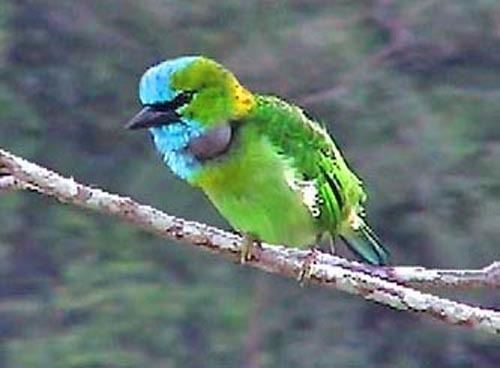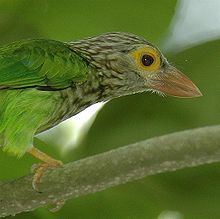Kingdom Animalia Scientific name Megalaimidae Higher classification Ramphastides Order Piciformes | Infraorder Ramphastides Phylum Chordata Rank Family | |
 | ||
Lower classifications Coppersmith barbet, Blue‑throated barbet, Lineated barbet, Great barbet, Brown‑headed barbet | ||
A family of birds comprising the Asian barbets, the Megalaimidae were once clubbed with all barbets in the family Capitonidae but the Old World species have been found to be distinctive and are considered, along with the Lybiidae and Ramphastidae, as sister groups. There are around 26 species living in the forests of the Indo-Malayan region from Tibet to Indonesia.

In the past the species were placed in three genera, Caloramphus, Megalaima and Psilopogon, but studies show that Psilopogon to be nested within the clade of Megalaima. Since members of this clade are better treated under a single genus, they have been moved to the genus Psilopogon which was described and erected earlier than Megalaima and is therefore chosen on the basis of taxonomic priority principles. Nearly all members of the family are now in the genus Psilopogon, with the exception of the Caloramphus which is thought to have diverged from the common ancestor early in the evolutionary history (around 21.32 MYA). The latter species is distinct enough to warrant placement in a distinct subfamily Caloramphinae. The family name is derived from that of the genus Megalaima which means ‘large throat’, from the Greek mega (μέγας, ‘large, great’) and laimos (λαιμός, ‘throat’).

The diversity is concentrated around the Malay Peninsula and Sumatra; it is therefore probable that the family originated there or thereabouts.
They are usually plump-looking, with large heads, and their heavy bill is fringed with bristles. The great barbet (Psilopogon virens), at 210 g (7.4 oz) and 33 cm (13 inches), is the largest of the species, and among its relatives is only surpassed in size by some of the toucans.
Asian barbets are usually birds of the inner forest. One species, the coppersmith barbet, is adapted to life on the forest edge and in scrub. They are mainly solitary birds, eating insects and fruit. Figs of the genus Ficus are the most important fruit taken by Asian barbets. Large fig trees will attract several species of barbet along with other frugivores. In addition to figs numerous other species of fruiting tree and bush are visited; an individual barbet may feed on as many as 60 different species in its range. They will also visit plantations and take cultivated fruit and vegetables. Fruit is eaten whole and indigestible material such as seed pits regurgitated later (often before singing). Regurgitation does not usually happen in the nest (as happens with toucans). Barbets are thought to be important agents in seed dispersal in tropical forests.
As well as taking fruit, barbets also take arthropod prey, gleaned from the branches and trunks of trees. A wide range on insects are taken, including ants, cicadas, dragonflies, crickets, locusts, beetles, moths and mantids. Scorpions and centipedes are also taken, and a few species will take small vertebrates such as lizards, frogs and geckos.
The precise nesting details of many species are not yet known. Like many members of their order, Piciformes, their nests are in holes bored into a tree, and they usually lay between 2 and 4 eggs, incubated for 13–15 days.
There is generally not much interaction between Asian barbets and humans. Some species, such as the great barbet and the lineated barbet, will raid plantations and orchards, particularly in India, and there is some capture for the cage-bird trade due to their attractive coloration.
Although none of the Asian barbets are considered threatened, several species are known to be intolerant of deforestation and require old-growth forest to thrive. For example, in Singapore only the second-growth-tolerant red-crowned barbet remains of the species originally found there, as well as the coppersmith barbet which has expanded its range and colonised Singapore in the 1960s.
Systematics
Subfamily Megalaiminae
Subfamily Caloramphinae
It is not entirely resolved whether the Early to Middle Miocene (23–12 mya) genus Capitonides from Europe belongs to this family or the African barbets (now Lybiidae). Indeed, given that the prehistoric birds somewhat resembled a primitive toucan, without these birds' present autapomorphies, they might occupy a more basal position among the barbet–toucan clade altogether.
